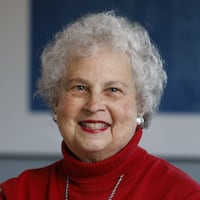And with this change comes changes for the museum's longtime volunteer docent program.
"The changes to our docent program reflect the changing needs of our audiences, moving from a traditional to experiential tour model," the museum's education curator Susan Martis explains. "Active art-viewing resonates with today's visitors."
CHANGES FOR THE DOCENTS
In a meeting called by Martis on June 1, the docents were told that in the future they will be referred to as “museum guides” and that a new group of guides will be added in the fall.
The last class began its intensive weekly training in 2012.
Martis also told the docents that their 45-year-old Docent Organization, which elected a new slate of officers last month, will morph into a volunteer committee that will work with staff liaisons in three specific areas — communications, membership and social.
Some of the docents who attended last week’s meeting — and met privately after the formal session — said they were “stunned” and “insulted” by the change of title and what they view as the dismantling of their volunteer docent organization.
“There has never been a separate organization; they are a part of the Dayton Art Institute,” said the museum’s director and CEO, Michael Roediger.
CHANGES FOR THE MUSEUM
As for the shift in title from “docent,” Roediger said it’s a term a lot of people don’t understand.
"Part of my goals is to make the museum more accessible and to minimize that fear that people have of not knowing enough about art," Roediger explained. "The term 'docent' seemed distant, and we want people to get immediately that a museum guide is going to take them on an experience."
The word docent is derived from the Latin word "docere," meaning to teach. According to the Dayton Art Institute's 2012 docent handbook, docents are "knowledgeable, enthusiastic people who act as liaisons between the museum and the general public and are professional volunteer museum staff members."
WHAT THE DOCENTS ARE SAYING
Pat Diven, a docent for five years, agrees with Roediger.
"Art in itself can be intimidating and arts organizations are struggling," she said. "I think there is justification for making it a more user-friendly word."
As for the structural change of the docent board, Diven also believes any institution and its administration have a right to function in the way they see fit. She believes the organization — not the volunteers — should set the parameters.
“Times have changed and what worked for many years may not work now,” Diven says. “The needs are different.”
The number of Dayton Art Institute docents has been steadily declining in recent years, according to Mary Ellen Graham, a retired teacher who has been a docent for the past 15 years. “In 2013, when I was docent chair we had 89 day and evening docents plus 27 in a new class,” she said. “Currently there are 44, but some of those have left in the past week or so.”
One of those was Bob Thum, a former teacher and 15-year veteran docent, who said he decided to resign because he didn’t like how the docents were being treated.
"There was no input from docents regarding tours and no particular interest in finding out what we thought of the tours the staff was writing for us," Thum said. "On a weekly basis, docents were becoming less relevant at the DAI."
Evan Valassiades, a docent for 22 years and former docent chair, is one of those trying to decide whether to stay or go. She loves being a docent and agrees that it’s important to keep up with new trends and learning techniques. But she believes invigorating the tours is a separate issue from taking away an earned title of docent from the men and women who have earned it just “because some people do not understand what the word means.”
"The action is simply a put-down to the docents and a dumbing-down to the public," Valassiades said. "I think Dayton people are smart enough to learn the term. To summarily disband a group that has had bylaws since 1977, officers, a small treasury from dues and a history of service to the DAI without talking about it is punitive. All this does is demoralize the group but to what end? What is the incentive to work harder, donate more time, effort and money to the DAI?"
Roediger said he wants all of the current docents to remain with the museum.
"We value their experience but we need to move with the times," Roediger said. "We do value this group of people and want them to stay as part of this transition."
About the Author


